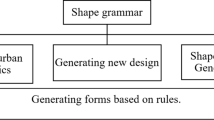Abstract
The BESO algorithm is a bionic algorithm often used in the design of architectural structures. With the help of the BESO algorithm, designers can design structures for buildings, bridges, etc. that are reasonably stressed and consume less material, thus reducing material losses. The forms generated by this algorithm often have a unique aesthetic and bionic character, and from the perspective of an industrial designer, this unique aesthetic is applicable to a wider range of product form designs. Therefore, we propose a new design method for children’s slide morphology by combining the BESO algorithm. First, we summarize the fallacies and causes of previous children’s slide designs, and summarize the elements of an ideal children’s slide form design. Secondly, we review the cases of application of BESO algorithm in building structure design, summarize the shape characteristics of its generated forms, and bring the algorithm into the process of generating the forms of various types of children’s slides to obtain different children’s slide forms. Third, we optimize the design of different slide shapes generated by the algorithm, and then obtain a series of children’s slide shape design solutions with unique aesthetics. Finally, we bring these structures into the case study and discuss the impact brought by human-computer interaction in the design process.
Access this chapter
Tax calculation will be finalised at checkout
Purchases are for personal use only
Similar content being viewed by others
References
Dabaja, Z.F.: The forest school impact on children: reviewing two decades of research. Education 3–13 (2021)
Xiang, H.: A study of children’s human-earth relationship with nature: contact, cognition and emotion. Hum. Geogr. 35(06), 9–17+75 (2020). (in Chinese)
Layard, R., Dunn, J.: A Good Childhood: Searching for Values in a Competitive Age: The Children’s Society, p. 124. Penguin, London (2009)
Kaiyan, S.: Research on sensory education in forest schools. Sci. Educ. J. (Late) 21, 50–51 (2018)
Louv, R.: Last Child in the Woods: Saving Our Children from Nature-Deficit Disorder. Algonquin Books, Chapel Hill (2005)
Skar, M., Gundersen, V., O’Brien, L.: How to engage children with nature: why not just let them play? Child. Geographies 14(5), 527–540 (2016)
Barad, K.: Meeting the Universe Half Way: Quantum Physics and the Entanglement of Matter and Meaning, p. 28. Duke University Press, Durham (2007)
Anggard, E.: How matter comes to matter in children’s nature play: posthumanist approaches and children’s geographies. Child. Geographies 14(1), 77–90 (2016)
Author information
Authors and Affiliations
Corresponding authors
Editor information
Editors and Affiliations
Rights and permissions
Copyright information
© 2022 Springer Nature Switzerland AG
About this paper
Cite this paper
Tian, W., Qin, Q., Tan, M. (2022). A Form Design Method of Children’s Slide Based on BESO Algorithm. In: Duffy, V.G., Rau, PL.P. (eds) HCI International 2022 – Late Breaking Papers: Ergonomics and Product Design. HCII 2022. Lecture Notes in Computer Science, vol 13522. Springer, Cham. https://doi.org/10.1007/978-3-031-21704-3_36
Download citation
DOI: https://doi.org/10.1007/978-3-031-21704-3_36
Published:
Publisher Name: Springer, Cham
Print ISBN: 978-3-031-21703-6
Online ISBN: 978-3-031-21704-3
eBook Packages: Computer ScienceComputer Science (R0)



